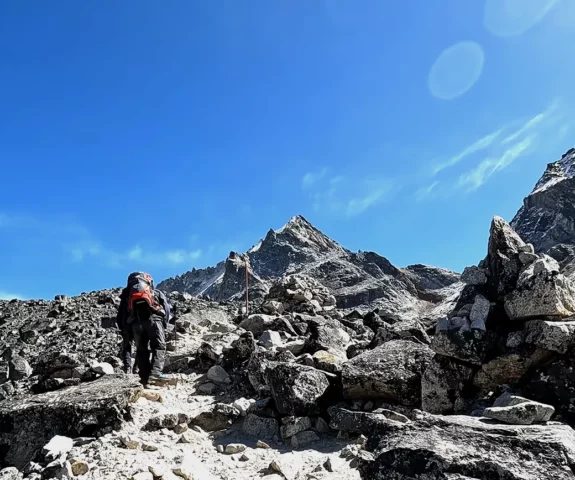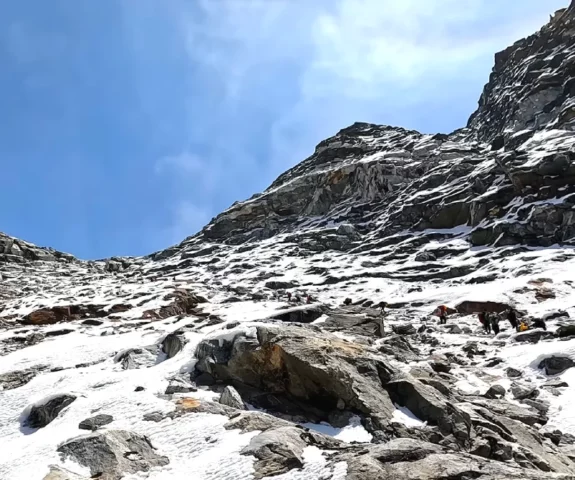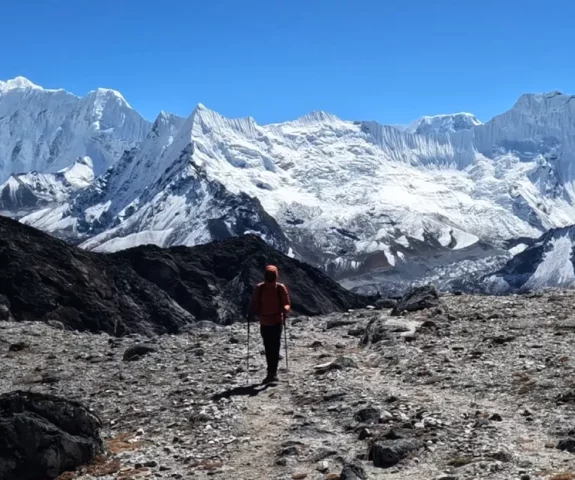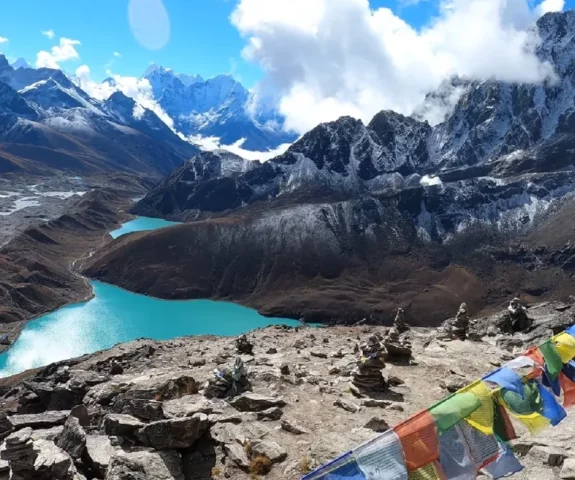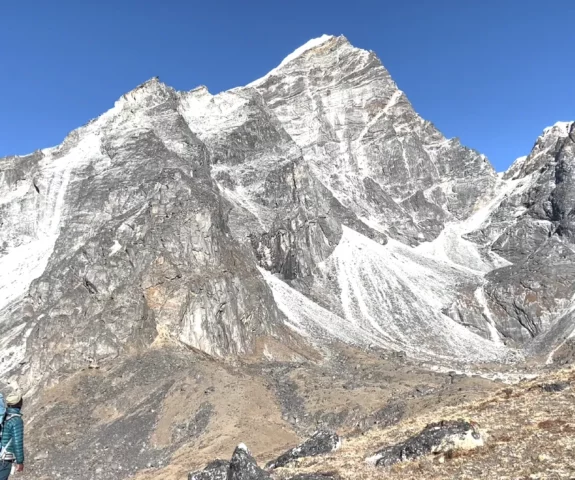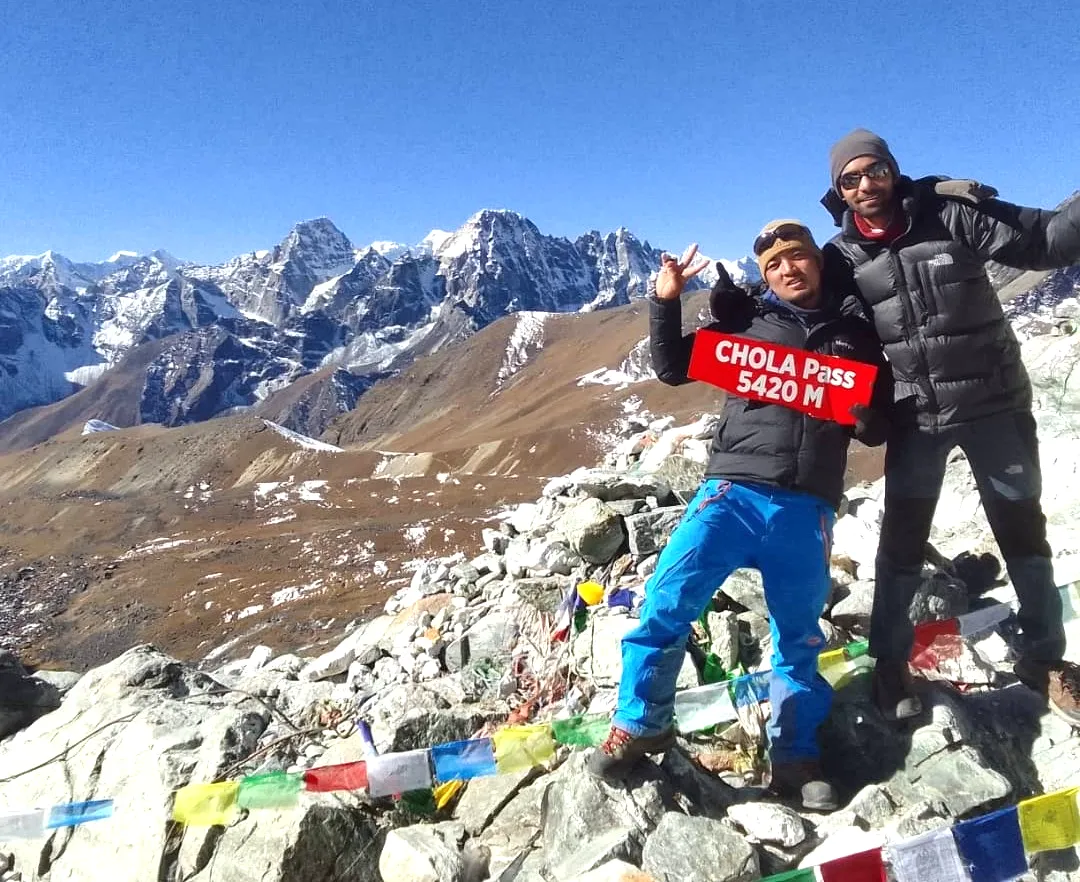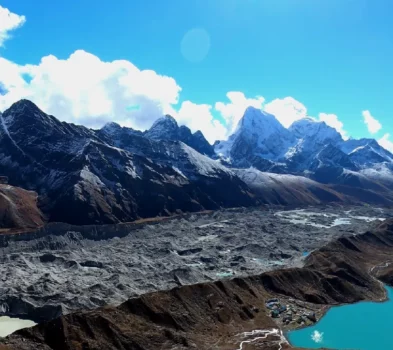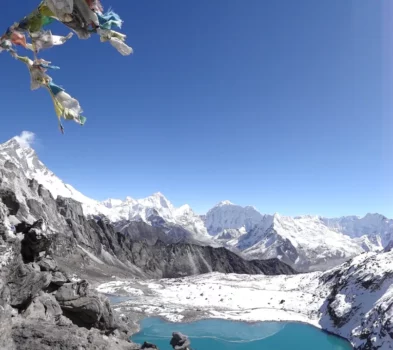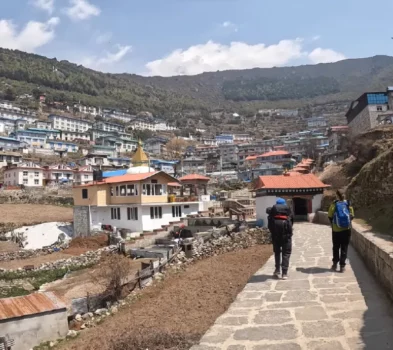Duration
17 DaysEverest Cho La Pass Trek
Trip Grade
DifficultGroup Size
1 - 16 PeopleMax Altitude
5,644m. / 18,517ft.Best Season
Feb- May/ Sept-NovActivity
Trekking & HikingMeals
Breakfast, Lunch & DinnerAccommodation
Hotels & TeahousesTransportation
Private Vehicle & FlightTrip Customization
On request (click here)Highlights of Everest Cho La Pass Trek
- The memorable enchanting flight to Lukla, an incredible start to the remarkable adventure
- An additional day at Namche with the exploration opportunity of Khumung and Hotel Everest View
- Hiking adventure along the serenely secluded trails of Dole, Macchermo, Thagnag, and Dzongla
- A non-technical ascent of the Gokyo Ri, Cho La Pass, and Kala Patthar- all in one adventure
- Feel the tranquil aura radiating from Everest, Pumori, Ama Dablam, Lhotse, Makalu, Cho Oyu, Nuptse and many more
- A magical night by the shore of Gokyo
- Meeting with the admirable EBC and Kala Patthar
- Embrace the spiritual air of Pangboche and Tengboche monasteries
- Intermingle with the renowned community of Sherpas
Trip Introduction
Are you hearing the stronger call of the high mountains? Do you want to feel the light breeze, the pure air, and the eternal peace by the shore of the holy Alpine Lake? If yes, then let’s tie our bootlaces and go together on a journey to the Everest Cho La Pass trek in the Everest Region.
We are not exaggerating when we say our Everest Cho La Pass trek is the top contender for the world’s best trekking trip, offering you a mosaic of culture, alluring nature, and the breathtaking hiking adventure amidst the realm of silhouettes of the high Himalayas.
We will be taking you to the magnificent lake system of Gokyo that towers to the staggering altitude of more than 4500 m. The group of six high alpine glacial lakes is positioned in the Sagarmatha National Park.
All of them are regarded as very pious by both the believers of Hinduism and Buddhism. Particularly at the Janai Purnima festival, the spectacle here is a sight to behold as thousands of devotees gather around the lake to dip in its holy water to cleanse their souls of a lifetime of sins.
Besides the profound religious importance, this lake is graced by the presence of the majestic Gokyo Ri summit, which elevates to 5360 m. It thus bestows each of its visitors with the wonderfully breathtaking panorama of Mount Everest (8848 m), Gyachung Kang (7952 m), Nuptse (7861 m), Cho Oyu (8188 m), Lhotse (8516 m), Makalu (8485 m), Cho Latse (6440 m), and Taboche (6495 m).
Complementing the sight is the presence of the Ngozumpa Glacier, the longest icy glacier in Nepal, the Renjo La and Cho La Passes.
As a pleasant bonus, our Everest Cho La pass trekking journey will also take you to the phenomenal Everest Base Camp resting at the foot of the mythical and iconic dimensional Mount Everest, which has the status of the world’s highest mountain.
And not far from EBC is the famous Black Rock, the Kala Patthar shining incredulously beneath the beautifully symmetrical peak of Pumori. Reaching its height, you will suddenly find yourself encircled by the mystical aura of not only Everest but also that of Pumori, Nuptse, Khumbutse, Changtse, Lobuche, Lhotse, Ama Dablam, and Lingtren.
However, between you, EBC, and Kala Patthar, there will be the enormous wall of Cho La Pass rising to 5368 m altitude. It will not only take you deeper into the realm of the High Himalayas and the real alpine world but will also challenge your endurance, adaptability, and determination.
For our EBC Gokyo Cho La Pass trek, we have extremely prioritized the excellent acclimatization and altitude adjustment. That’s why we will first experience the amazing Gokyo Valley before moving to the upper layers of Khumbu.
The pathway will initially lead you to the Everest trail up to Namche Bazaar. Then, you will travel along the secluded path running through the small yet enchantingly mesmerizing towns of Dole, Macchermo to reach Gokyo.
After you spend a night in the serene embrace of Gokyo’s shimmering lakes, you will ascend the majestic Gokyo Ri and then tackle the formidable challenge of Cho La Pass.
The pass separates the Gokyo Valley from the Khumbu and will guide you to the eagerly anticipated trail of Everest Base Camp, traversing through the iconic landscapes of Lobuche and Gorakshep.
After an enthralling meeting with the EBC and Kala Patthar, you will then begin the end of our Everest Cho La Pass trek and journey back home to Kathmandu via Pangboche, Tengboche, Namche, and Lukla.
Our Everest Cho La Pass trek is not exactly mountaineering, and two summits and one mountain pass exceeding 5000 m altitude do not pose any technical challenges. But it is still necessary to be a well-prepared and well-equipped person.
Both a perfect physical shape is required, to tolerate the challenging altitudes to which we will take ourselves, and adequate physical preparation to face before departure.
Outline Itinerary of Everest Cho La Pass Trek
Day 01: Arrival at Kathmandu Airport.
Day 02: Fly from Kathmandu to Lukla and trek to Phakding (2610 m).
Day 03: Trek from Phakding to Namche Bazaar (3446 m).
Day 04: Acclimatization day Visit Khumjung Village, Hotel Everest View (3880 m).
Day 05: Trek from Namche Bazaar to Dole (4110 m).
Day 06: Trek from Dole to Machhermo (4470 m).
Day 07: Trek from Machhermo to Gokyo (4790 m).
Day 08: Rest day at Gokyo & explore the Gokyo Ri (5360 m).
Day 09: Trek from Gokyo to Thagnag (4700 m).
Day 10: Trek from Thagnag to Dzongla (4830 m) via Cho La pass (5368 m).
Day 11: Trek from Dzongla to Lobuche (4910 m).
Day 12: Trek from Lobuche to Gorakshep (5140 m) to visit EBC (5360 m).
Day 13: Trek from Gorakshep to visit Kalapatthar (5644 m) to Pangboche (3930 m).
Day 14: Trek from Pangboche to Namche Bazaar (3440 m).
Day 15: Trek from Namche Bazaar to Lukla (2840 m).
Day 16: Flight from Lukla to Kathmandu.
Day 17: Departure to Kathmandu Airport.
Our guests sharing their experiences (Photo/Video Gallery)
Detail itinerary of Everest Cho La Pass Trek
Day 01: Arrival at Kathmandu Airport.
Welcome to the unique Kathmandu, where all your Himalayan journey begins. As you step out of the airport, you will find our representative with a sign in hand, ready to take you on a private ride to your hotel.
After you check in, take a moment to relax, afterward you will have time to buy any necessary gear. Where is the best place to do this and not get lost in the noisy streets, our guide will tell you in detail.
Later in the evening, our guide will tell you all about the travel program of our Everest Cho La Pass trek and everyone will also get to know each other.
*** During the poor weather, in the very busy hiking and climbing season of fall and spring, the Lukla flight from Kathmandu is often rerouted to Manthali Airport located in the Ramechhap town for which the 4-hour road travel is a must from Kathmandu.
*** This journey can take place early around midnight so it is wise that you plan to arrive in Kathmandu early in the morning so you will have the whole day for rest and preparation for the EBC Gokyo Cho La pass trek.
Activity: Airport Pickup, 30 min
Max. Altitude: 1,400m/4,593ft. Kathmandu
Accommodation: Hotel
Day 02: Fly from Kathmandu to Lukla and trek to Phakding (2610 m).
After an early morning departure to the domestic airport, we will approach the flight to the Lukla town of Everest region. This will be an utterly stunning mountain flight of your life when you can gaze at Kanchenjunga, Manaslu, and Everest literally pass by beneath your feet.
And, the landing will be equally exciting as you wait for the plane to stop at the shortest runway of the airstrip. 6187 m high Kongde Ri will wave you as soon as you exit the small aircraft.
Now, you will have a small meeting with our Sherpa guide and porters then you will depart to take the first walk which will gradually lead you to the amazing Gokyo and Cho La Pass.
Our walk today will not be that long and we will also lose some altitude which is good for our acclimatization. We will take the path that gracefully follows the mesmerizing milky waters of Dudh Koshi River.
Following the river, we will navigate through the amazing little Sherpa settlements of Chheplung, Chaurikharka, and Thadokoshi. From here on, 6367 m Mount Kusum Kanguru will join us on our adventure.
We will keep on walking downward and pass through Ghat before we arrive at Phakding. The magical profile of 5761 m Khumbila Peak will be clearly visible from the town.
Activity: Flight & Trek, 4-5 hours
Max. Altitude: 2,610m/8,563ft. Phakding
Meal: Breakfast, Lunch & Dinner
Accommodation: Teahouse
Day 03: Trek from Phakding to Namche Bazaar (3446 m).
After we leave Phakding, we will once again walk enjoying the cascading waters of Dudh Koshi River that runs north. The route will go straight up the hill and pass through the beautiful oasis of rhododendrons and pines.
At Toktok, we will meet an enticing waterfall and not far away, we can see the striking image of Thamserku (6609 m). Soon, we will arrive at Benkar where our trail will guide us across the river of Dudh Koshi along the highly suspended metal bridge.
Now, the trail will climb towards Chomoa till we reach Monjo. Here, our pathway will enter into the Everest (Sagarmatha) National Park. At the park entrance, the rangers will check our permits to ensure we have paid the entrance fee and register our arrival.
We will again resume upward walking through the stunningly adorned path along the dense thickets of rhododendrons, magnolias, and firs as we reach Jorsalle.
After around half an hour of gentle upward hike, we will arrive at the iconic and very long and high suspended bridge of Hilary that arches over the meeting point of three rivers: the Bhote Koshi, the Dudh Koshi, and the Imja Khola River.
We can see the sacred Sherpa peak of Tarboche (6495 m) as we walk across the bridge. Then after an hour, we will arrive at yet another dazzlingly beautiful spot of Top Danda (3140 m) from where we can see the exquisite figures of Nuptse, Everest, and Lhotse.
Now, this final stretch can be pretty challenging so it is important not to tire, so walk slowly till we make it to Namche Bazaar.
Activity: Trek, 6-7 hours
Max. Altitude: 3,446m/11,306ft. Namche Bazaar
Meal: Breakfast, Lunch & Dinner
Accommodation: Teahouse
Day 04: Acclimatization day Visit Khumjung Village, Hotel Everest View (3880 m).
Namche Bazaar is positioned at a significant elevation, therefore, here we can feel the first signs of altitude sickness. To ensure that we have a successful journey on our Cho La Pas trek, it is important that we spend another night at Namche to allow our bodies to adjust to the new environment.
Today, we will go to the village of Khumjung, home to a mountaineering museum and the intriguing Yeti scalp. Additionally, we will also make a stop at the Everest View Hotel, a luxurious Japanese establishment particularly designed for those who like to observe Everest and its sister companions without trekking to the base.
After all the necessary exploration in Khumjung, we will make our descent back to Namche Bazaar.
Activity: Hike, 4-5 hours
Max. Altitude: 3,881m/12,733ft. Khumjung Village
Meal: Breakfast, Lunch & Dinner
Accommodation: Teahouse
Day 05: Trek from Namche Bazaar to Dole (4110 m).
We are about to reach new heights today as we ascend to the heights of more than 4000 m at Dole. Taking our time, we will slowly approach Kyangjuma observing the striking profiles of Thamserku, Nuptse (7861 m), and the breathtaking Ama Dablam (6812 m).
Now, hugging the slope of rhododendrons, we will travel to Sanasa. Here, the trail splits: the right one goes up to Everest Base Camp while the left one will be our trail.
Get ready to climb the trail that rises sharply along the steep staircase that has been carved into the cliff. We will be atop the 3973 m Mongla Danda which bestows the remarkable view of the Tengboche Monastery.
Now, moving downward through the densely rich forest, we will reach Phortse Thanga. Giving way to the fat yaks, we will slowly approach Dole, our resting place for the night.
Activity: Trek, 5-6 hours
Max. Altitude: 4,110m/13,484ft. Dole
Meal: Breakfast, Lunch & Dinner
Accommodation: Teahouse
Day 06: Trek from Dole to Machhermo (4470 m).
Today promises to be a very short, simple, and beautiful day for the EBC Gokyo Cho La Pass trek as we will walk only 6 km gaining almost 300 m. As we advance with our hike, we will wander through the green grasslands that have taken the place of the once-thick forest.
We will first traverse the pasture of the Lhabarma Kharka and then of Luza Kharka. Macchermo is not that far now and the route is more enjoyable as we glimpse at the white silhouettes of Thamserku, Cho Latse, Cho Oyu, and Tawache.
Here we are at Macchermo on time to eat our lunch. Then we will go out for a small acclimatization walk around the small village.
Activity: Trek, 5-6 hours
Max. Altitude: 4,470m/14,665ft. Machhermo
Meal: Breakfast, Lunch & Dinner
Accommodation: Teahouse
Day 07: Trek from Machhermo to Gokyo (4790 m).
Today, we are set to reach one of Nepal’s most enchanting treasures: the high alpine glacial lake of Gokyo. Located beneath the feet of the Himalayas, there are five lakes in total that make up the Gokyo Lake.
Today, we will traverse only three and the remaining two will be left for tomorrow. After leaving Macchermo, we will ascend the ridge and advance towards 4390 m high Pangka.
Prepare as you will have to trek upward along the more rugged trail towards the rocky terrain of Nilibuk. The new pathway has been formed here for ease and then one by one we will approach the first Gokyo Lake: Longponga Lake at 4,560 m, Taujung at 4,720 m, and Dudh Pokhari at 4,790 m.
This third lake is the enthralling Gokyo Village that will treat us with the outstanding visuals of Cho Oyu (8188 m), Kangtega (6782 m), and Ngozumpa glacier, which nourishes these lakes with its melted water.
Activity: Trek, 5-6 hours
Max. Altitude: 4,790m/15,715ft. Gokyo
Meal: Breakfast, Lunch & Dinner
Accommodation: Teahouse
Day 08: Rest day at Gokyo & explore the Gokyo Ri (5360 m).
Today is a big day for many of us as we will be heading to the summit of Gokyo Ri which rises to 5360 m. Its altitude is more than some of the peaks that are found in the world so it will be the major milestone in your trekking career.
The climb to this summit is not technically complicated, but it will be a true test of your resolve and determination. We will commence our climb before dawn and cross the small stream en route.
After about 2 to 4 hours, we will be already atop the summit meeting the beautiful dawn over Mount Everest, Gyachung Kang, Nuptse, Cho Oyu, Lhotse, Makalu, Cho Latse, and Taboche.
The ancient Ngozumpa Glacier, the longest icy glacier in Nepal, along with the Renjo La and Cho La Passes will also be visible from here. After spending 30 to 40 minutes at the summit to capture the moment in photographs, we will begin our downward journey.
If you think you have some energy left, then you can venture out to explore the remaining two lakes of Gokyo: Thonak Cho (4,840 m) and Ngozumpa Cho (4,980 m).
Our evening will be again in the warm humble lodge of the stunning Gokyo Village.
Activity: Hike, 4-5 hours
Max. Altitude: 5,360m/17,585ft. Gokyo
Meal: Breakfast, Lunch & Dinner
Accommodation: Teahouse
Day 09: Trek from Gokyo to Thagnag (4700 m).
From Gokyo, we will take the snow-covered track that will lead us to Tanjung Pokhari. Here, the trail diverges: one path will go to the Macchermo and the other one will take us to our intended destination.
Tracing the edge of the moraine, we will climb the ridge and cross the vast expanse of the Ngozumpa Glacier that lies at the foot of Cho Oyu. We will navigate carefully the crevasses for about 45 minutes and finally scramble back up the moraine wall on the glacier’s western flank.
The route will now take us down into the lower Valley where Thagnag awaits our arrival.
Activity: Trek, 5-6 hours
Max. Altitude: 4,701m/15,423ft. Thagnag
Meal: Breakfast, Lunch & Dinner
Accommodation: Teahouse
Day 10: Trek from Thagnag to Dzongla (4830 m) via Cho La pass (5368 m).
We will start out very early today following the rule of alpine start. We will be crossing the mighty Cho La pass today which is also lovingly known as Chhugyuma La in the Sherpa language.
The Pass is not technically challenging, but we must be prepared for the strenuous hike, with steep inclines and biting cold. We will traverse the narrow valley of Phedi and come along the rugged terrain.
A three to four hour long journey will advance us towards the the high alpine frozen lake. After crossing the lake, we will undertake the last inclined section that will lead us to the ultimate height of the Pass.
Here they are, the majestic kingdom of the real Himalayas that include Lobuche, Everest, Makalu, Nuptse, Lhotse, and the mountains of Rolwaling stretching out to the horizon.
After this memorable moment, we will now make our gradual descent into the Khumbu Valley, arriving at the stunning Dzongla for the night.
Activity: Trek, 7-8 hours
Max. Altitude: 4,830m/15,846ft. Dzongla
Meal: Breakfast, Lunch & Dinner
Accommodation: Teahouse
Day 11: Trek from Dzongla to Lobuche (4910 m).
From Dzongla, we will start to walk down for around two hours to reach Dughla. From here, we will face a challenging climb up to the Dughla Pass, a solemn place filled with countless symbolic graves of deceased Sherpas and mountaineers on Mount Everest.
Here, we can also see one of the most beautiful profiles of Pumori (7161 m) that rises majestically along with Lobuche, and Ama Dablam. The terrain is high alpine and delicate that now goes easily along the small river taking us to Lobuche.
Activity: Trek, 5-6 hours
Max. Altitude: 4,910m/16,109ft. Lobuche
Meal: Breakfast, Lunch & Dinner
Accommodation: Teahouse
Day 12: Trek from Lobuche to Gorakshep (5140 m) to visit EBC (5360 m).
The next phase of our Everest Cho La Pass trek will now take us to EBC today. After Lobuche, we will follow the trail on the western side of the wide Khumbu Valley.
We will then gently climb through meadows beside a glacial moraine. The conical summit of Pumori, Lingtren, Mahalangur, and Khumbutse can be seen as we move on along the steeper and uneven terrain.
We will reach the Thangma Riju Pass commonly called the Lobuche Pass and then move to cross the lateral moraine of Changri Glacier. After a bend, we will see the ridge of Kala Patthar just below the Pumori.
We will now move down to the sandy expanse of Gorakshep where we will deposit our belongings and lift our spirits with a hot hearty meal. Now, it is time that we follow the route that moves through the upper part of Khumbu moraine and its glacier.
Finally, here we are at the EBC lying in front of the enormous Khumbu Icefall. Although we may not see Everest, but Nuptse and Lhotse will be there to dazzle us with their beauty.
Let’s retrace back to Goraskhep as we have yet another climb to deal with tomorrow morning.
Activity: Trek, 6-7 hours
Max. Altitude: 5,360m/17,585ft. EBC
Meal: Breakfast, Lunch & Dinner
Accommodation: Teahouse
Day 13: Trek from Gorakshep to visit Kalapatthar (5644 m) to Pangboche (3930 m).
Yet another day for the very early alpine start as we are set to head straight for Kala Patthar, the stunning sugar peak of Pumori at its tail. The path leading us to the top of this Black Rock is not that challenging but the hike can be strenuous particularly due to high elevation and frigid cold.
At first, the track will go steeply up and then easy until the final boulder. Now, the very last meters to the summit will be quite battle but at last, we will be at the tip where we can see the first sun ray touching the black tip of Everest.
We will also be able to see the walls of Pumori, Nuptse, Khumbutse, Changtse, Lobuche, Lhotse, Ama Dablam, and Lingtren. We will now go down to Gorakshep, pack our belongings, and go down the familiar road towards Pangboche.
Lobuche, Dughla, and Pheriche will be traversed first which will take us to the familiar beautiful sighting of Imja Khola River. Here we are at Pangboche known for the prehistoric monastery with the relic of its stolen Yeti scalp.
Activity: Trek, 6-7 hours
Max. Altitude: 5,644m/18,517ft. Kalapatthar
Meal: Breakfast, Lunch & Dinner
Accommodation: Teahouse
Day 14: Trek from Pangboche to Namche Bazaar (3440 m).
After we leave Pangboche, w make our way down to Imja Khola, cross it, and then enter the vast green zone of the Khumbu Valley. Our route will now be relatively easy and flat running through pine, birch, juniper, and rhododendron trees taking us to the lovely village of Deboche.
The trail will now ascend sharply to the monastic grounds of Tengboche, which is undoubtedly the most significant monastery for the Sherpa community.
We will have the opportunity to visit the monastery after which we will take on another sharp descent of about 600 m to reach Phunki Thenga (3250 m).
We will again walk across another hanging metal bridge and walk through Tashinga, Sanasa, and Kyangjuma. Giving a final glance to Ama Dablam, we will now travel to Namche where we will be back again in the comfort of warm accommodation.
Activity: Trek, 5-6 hours
Max. Altitude: 3,440m/11,286ft. Namche Bazaar
Meal: Breakfast, Lunch & Dinner
Accommodation: Teahouse
Day 15: Trek from Namche Bazaar to Lukla (2840 m).
We say goodbye to the highest snowy giants and continue along the familiar path of Top Danda, Jorsalle, and Monjo. We will leave the National Park of Everest and hike along the young tracks running through Benkar, Phakding, Thadokoshi, Chheplung, and Chaurikharka to step once more at the land of Lukla.
Activity: Trek, 6-7 hours
Max. Altitude: 2,840m/9,318ft. Lukla
Meal: Breakfast, Lunch & Dinner
Accommodation: Teahouse
Day 16: Flight from Lukla to Kathmandu.
The moment has come for us to once again fly in the small aircraft that will return us either to Ramechhap or Kathmandu. After a breathtaking take-off, in about 40 minutes, we will be back again in the noise and frenzy of the city.
Let’s celebrate our evening with an eye and tongue-pleasing dinner with our team and revel in the moments that we spend together in Everest.
Activity: Flight, 40 min
Max. Altitude: 1,400m/4,593ft. Kathmandu
Meal: Breakfast & Dinner
Accommodation: Hotel
Day 17: Departure to Kathmandu Airport.
The beautiful and intrepid travel journey of our Everest Cho La Pass trekking has ended. As we see you off at TIA, we await the day we will reunite again. We wish you a truly delightful journey back home.
Activity: Airport drop, 30 min
Max. Altitude: 1,400m/4,593ft. Kathmandu Airport
Meal: Breakfast
Note:
If you have your own private group and want to make your trip private, we can run the custom trip all the day as per your requirements and group size.
Includes and Excludes
What are included with package?
- Pick-up from Airport and Transfer to Hotel: Upon arrival at the airport, you will be greeted and transferred to your hotel in Kathmandu.
- Two Nights in a 3-star Hotel in Kathmandu with Breakfast: Your stay in Kathmandu is at a comfortable 3-star hotel, with breakfast included each morning.
- Lunch, Dinner, and Breakfast During Trekking: All meals (breakfast, lunch, and dinner) during the trek are included. These will be provided at teahouses or lodges along the trekking route.
- National Park Permit: The cost of your National Park Permit (for the region you are trekking) is included. This is a mandatory requirement for all trekkers in certain areas.
- Trekkers’ Information Management System (TIMS) Permit: The TIMS permit is a vital document for trekkers in Nepal. It helps to ensure the safety and regulation of trekkers throughout the trekking areas.
- All Necessary Paperwork: The required paperwork for permits, registrations, and other logistics will be handled for you.
- Domestic Airport Pickup and Drop: Your domestic flights to and from Lukla or Ramachap are included, along with transfers to and from the airport.
- Flight Ticket (LUK-KTM-LUK or Ramachap to Lukla and Ramachap): A round-trip flight from Kathmandu to Lukla (or Ramachap to Lukla and Ramachap) is included in the package, along with all domestic airport taxes.
- All Accommodations in Lodges/Tea Houses During the Trek: During your trek, you will stay in basic, comfortable lodges or tea houses, typically on a twin-sharing basis.
- An Experienced, Helpful, and Friendly Guide & Porter (1 Porter for 2 Clients): You will have a professional, experienced trekking guide to assist you throughout the trek. For every two trekkers, one porter will be provided to help with luggage, making your journey easier.
- Travel and Rescue Arrangements: Travel and emergency evacuation arrangements are covered. This ensures that you are prepared for any unforeseen circumstances during the trek.
- Medical Supplies (First Aid Kit): A first aid kit will be available during your trek, and your guide will be trained to handle minor injuries or health issues.
- Last Night Farewell Dinner at an Authentic Nepalese Restaurant with a Cultural Performance: After completing your trek, you will enjoy a farewell dinner at a traditional Nepalese restaurant with a cultural performance, providing you with a memorable end to your trip.
What are not included with package?
- Nepal Visa Fee: The visa fee for Nepal can be obtained upon arrival at the Kathmandu airport. This fee is not included in the package.
- International Airfare to and from Kathmandu: The cost of your international flights to and from Kathmandu is not included. You will need to book your own international flights.
- Extra Night Hotel Accommodation in Kathmandu: If you arrive earlier than expected, have a late departure, or need to return early from the mountain (for any reason), any extra nights in Kathmandu will be your responsibility.
- Meals in Kathmandu: All meals in Kathmandu (except for breakfast at your hotel) are not included. This includes lunch and dinner in Kathmandu. If you return early from the mountain, meals outside of your scheduled itinerary will also be at your own cost.
- Expenses in the Mountain Over the Scheduled Itinerary: If there are any unexpected delays due to bad weather or other unforeseen circumstances that extend your time on the mountain, any additional costs (such as accommodation, meals, and other services) will be your responsibility.
- Travel and Rescue Insurance: Travel insurance, including rescue and evacuation insurance, is not included. You are required to arrange and ensure you have adequate travel and rescue insurance coverage.
- Personal Expenses: Personal expenses such as phone calls, laundry, bar bills, battery recharges, extra porters, bottled or boiled water, hot showers, and other personal items will not be covered and will be your own responsibility.
Pick Your Suitable Date
Book a Private Trip
Private & Group Discount Price
-
1 -
1 person
US$ 1800
-
2 -
2 people
US$ 1400
-
3 -
5 people
US$ 1300
-
6 -
10 people
US$ 1200
-
11 + people
9999
US$ 1100
Total Cost:
US$ 1800
Route Map & Altitude Chart
Kathmandu
Start/End point
Kathmandu
Addon option on Everest Cho La Pass Trek
Kathmandu today has turned into a vibrant metropolis that houses elegant hotels and resorts that meet international tourist standards with four and five-star ratings.
They are known for the exceptional service they offer to guests including the in-built gyms, spa centers, pools, restaurants, and cozy lounges. Not all but most of the rooms will have balconies to offer you the enchanting scenery of the city’s captivating landscape.
But the allure of luxury is not limited to Kathmandu only, now the trail leading to Everest Base Camp also presents premium accommodations where you can literally enjoy sushi, organic cuisine, spa treatments, and jacuzzis high in the majestic Himalayas.
Such premium extravagant experiences can be found in Lukla, Phakding, and Namche Bazaar. If you also want to have such delicious accommodation, in the enchanting Himalayan kingdom and Sherpa territory, please let us know, and we will set up the arrangements for you before your arrival in Nepal. Do keep in mind that these premium services will need an added price.
Taking an internal flight from Kathmandu to Lukla can often lead to the inconvenience of rerouting to Ramechhap Airport, which requires an additional four-hour road transfer in the middle of the night.
Additionally, these flights are heavily influenced by weather conditions, which frequently results in delays or cancellations due to poor visibility. All these hassles can add unnecessary stress on you before your adventure even begins, which is the last thing we want.
Therefore, we offer you the option of a helicopter ride from Kathmandu to Lukla to Kathmandu. You can choose a one-way trip or opt for a round trip. Additionally, if you wish to cut short your trekking days, you can take a helicopter flight back from Gorakhshep directly to Kathmandu.
The benefit of the helicopter ride is that it is less affected by weather conditions, and gives you the flexibility to choose your preferred flight time. Please be cautious about the added price that will associated with helicopter upgrade.
Trip Information
Best Time Period for the Everest Cho La Pass Trek
Within 17 days of our Everest Cho La Pass trekking journey, you will get to experience both the subtropical and high mountain climates of Nepal. Usually, the lower areas below 3000 m altitude are generally warm even in winter while the Himalayas are always cold and unpredictable.
Therefore, the best comfortable trekking season for our Cho La pass trek would be spring (March – April/early May) and autumn (October and November). During these periods, the temperature in the Everest region will be pleasant and you will have the best chance of beautiful panoramic views of the mountains.
In the period of mid-March/early April, the rhododendron forests are in full bloom creating an enormous sea of flowers, a beautiful sight. In winter (Mid-December/Late February), there will be extreme cold, snowfall, and of course, blowing wind causing snowstorms sometimes. Thus, this season is only suited for advanced hikers and climbers.
From June to early September, it is monsoon and summer in Nepal with a combination of high heat, rain, and high humidity providing oppressive weather. Heavy rainfalls often lead to landslides, floods, the destruction or blocking of land routes, and even cutting off some regions from the rest of the country.
Challenges of the Everest Cho La Pass trek
The Everest Cho La Pass trek is one of the most treacherous, demanding, difficult, and arduous trekking trips that you can take in the Khumbu region.
The unpredictable high-altitude weather, rugged alpine landscapes, and high elevations, the real risk of Acute Mountain Sickness (AMS), the three formidable obstacles rising above 5000 m and the frequent steep inclinations contribute to the intensity of this trek.
As you journey, you will meander through dense thick forests that are often covered in slippery moss. Sometimes you have to overcome the fallen trees and sometimes cross the high and long swaying hanging metal bridge.
Likewise, the trail often clings to the cliff or ridge with sheer drops on one side and sandy slopes that go down to rushing rivers. You will also encounter numerous crevasses, and boulders as you prepare to tackle the Cho La Pass and Kala Patthar.
Adding to the trek’s complexity is the remote Gokyo Valley, where for a few days you will have to make do with the basic comforts. Thus, the Cho La Pass trek is really a true wilderness and alpine trek that needs you to be an expert in trekking, with very excellent physical and mental shape, fitness, and health.
Who is the EBC Gokyo Cho La Pass trek appropriate for?
The Everest Cho La pass trek is definitely not an easy feat, and one of the toughest trekking adventures that in return for your hard effort promises you with the most hypnotizing vistas of the high Himalayas you can ever imagine to see.
However, it is important to note that this trek involves ascending not just one or two, but three high-altitude ridges and Everest Pass, whose elevations exceed those of many snowy mountains that are found elsewhere in the world.
Additionally, you will also reach Everest Base Camp which adds another exhilarating challenge. Within 15 days, you will engage in hiking for approximately 5 to 7 hours each day when you will traverse various terrains and weather conditions.
There will be no need for any technical gear but the trek does involve challenges associated with high altitude and steep inclines for which you will have to remain extra vigilant.
Therefore, the Everest cho la pass trek is made for those who genuinely want to conquer the great heights, reach the mountains, and delight in the true wilderness of nature.
Yes, the high-altitude experience will be essential for the journey, but if you are an excellent fit and athletic person, if you have adequate training, then you can take part in this adventure even if you are a beginner.
Acute Mountain Sickness/AMS/Altitude Sickness and Acclimatization
During a high-altitude Everest Cho La pass trek, you may come into contact with altitude sickness. In every trek in Nepal, we always emphasize extra acclimatization and adaptation processes.
This time also, we have particularly focused on acclimatization by first guiding you to Gokyo Valley and then only taking you to the high-altitude environment of Everest Base Camp (EBC).
This approach offers adequate opportunities for adaptation, first with an additional day at Namche Bazaar, followed by an extra day at Gokyo Village. By the time you arrive at Cho La Pass, you will be well-prepared to handle the thin air.
However, you will still suffer from mild symptoms before you are fully acclimatized to the altitude and the associated conditions. The resulting symptoms can vary from one to another, but the frequent ones include headache, reduced appetite, dizziness, vertigo, exhaustion, and some swelling of hands and feet. They will, however short-lived and go away slowly on their own.
Our accompanying trekking guides are highly skilled and have practical knowledge of how to deal with such occurrences. If needed, he will delay your trekking expedition or take you to a lower zone.
To prevent altitude sickness to a certain degree, we recommend you drink between 4 to 5 liters of water per day. Place a little strain on your body and walk slowly.
In case of mild symptoms, you can take aspirin, rest, and shower with lukewarm water. Diamox is one of the medicines that you can take on your personal choice before the climb at a higher altitude.
How to prepare oneself for the Everest Cho la Pass trek?
The Everest Cho La Pass trek is an extraordinary feat that needs a long preparation before you set on this journey. Therefore, we suggest you commence your physical training 3 to 4 months before you plan for your departure to Nepal.
Your focus should be on enhancing your endurance, building leg strength, increasing lung capacity for better oxygen absorption, and improving overall stamina.
You should thus engage in walking, running, swimming, cycling, or stair climbing. Additionally, you should also consider joining a gym that will provide you right professional guidance.
You should also gain knowledge about the actual conditions in high altitude therefore, we suggest you undertake a hiking expedition to at least 3,000 m within your home country.
In Nepal, you can start with either the Everest Base Camp trek or the Gokyo Valley trek only before attempting both in a single journey. It is also important to gain information about the Gokyo Valley and Khumbu Valley so you can set realistic expectations for your trip.
And, please note, in high alpine conditions like this, you must be prepared to follow what the guide says, as he best knows what is better for you.
Is there any other route to the EBC Cho La Pass trek?
Yes, some hikers like to first journey to Everest Base Camp and Kala Patthar before entering the Gokyo Valley. After their ascent of Kala Patthar, they make their way to Dzongla, cross the Cho La Pass, and trek to Thagnag and the Gokyo Lakes.
They then make their return through Dole, Namche, and Lukla. This approach is more fitting for experienced hikers because of the steep elevation gain associated with this route.
Accommodation and Dining on Everest Cho La Pass Trek
During the 17 days journey in our Everest Cho La Pass Trek, all your overnight stays in Kathmandu and villages en route will be taken care of. In Kathmandu, we will be providing you with the experience in one of the fine three-star rated hotels.
You will be provided with a room consisting of two single large beds that has its own bathroom with a constant hot shower and free WiFi.Breakfast will be catered to you every morning. You will be independent in choosing your own lunch and dinner menus.
During the trekking part, all your overnight stays will be arranged in the best available mountain shelters commonly called the tea house. Along the Everest trail, you will have pretty modern accommodation and you can even have hot water for a shower, the choice of single room, WiFi, and charging facilities.
In Gokyo Valley, however, you have to be prepared for a modest setting as these are pretty remote still and less frequented by the trekkers. Lunches, breakfasts, and dinners will be served every day of the hike. This is a complete lodge trek which means there will be no need for camping.
Transportation
As part of our expansive transportation service, we offer you airport and hotel transfers along with internal airport transfers as well. We will also manage your internal all-around Lukla flight that can take place from Ramechhap or Kathmandu. If needed, a private 4-wheel vehicle will be on your service for your road travel from Kathmandu to Ramechhap to Kathmandu.
Cellular Service and WiFi/Internet
Our remarkable Everest Cho La Pass Trek is an adventure that revitalizes your energy so we advise you to stay disconnected for a few days so you can completely immerse yourself in the wonderful raw nature of the Gokyo Lakes.
However, you will not be completely out of touch though as you will have access to cellular services and internet throughout the journey. Almost all smartphones can use Nepalese physical or virtual SIM cards from NCELL or NTC, and you can also take advantage of 4G in the stunning Gokyo and Khumbu Valley areas.
Plus, lodges on the Everest Base Camp trek also provide unlimited or hourly Wi-Fi. The alternate option of purchasing prepaid internet cards from Everest or Nepal Airlink en route is also available.
Travel Insurance
Travel insurance is not only a prerequisite but also an extremely important element of our Everest Cho La Pass trek. The high-altitude route of the Gokyo and Khumbu valleys can not only be difficult but demanding as well.
Additionally, the climate and the terrain intensify the challenge and if any medical evacuation is needed, it will be very pricey in Nepal. So, you should have a very complete travel insurance that includes medical compensation in case of any sudden accident or illness that can help you also in further rehabilitation.
There are excellent medical care available in the larger city of Kathmandu, which are not to mention pretty high cost but the medical care at remote areas such as Gokyo are also very limited. Thus, transportation to the medical facility in another city may be necessary.
Your insurance must also have rescue and helicopter evacuation coverage extending to a high altitude of more than 5000 m. The Himalayas are often the cause of AMS, injury, or accident, and the sole option for swift transport is by helicopter.
Trekking and traveling in Nepal can also be associated with unforeseen flight delays, any changes in hiking schedules, poor climatic conditions, or health problems.
Thus, your insurance should also cover the loss incurred due to trip or flight cancellations. Similarly, during your travel, your belongings may get lost, damaged, or delayed in which case, your insurance should compensate you for your loss of gear, clothing, documents, or any other valuables.
Is trekking alone to Everest and Gokyo Possible?
No, implemented from the April month of 2023, trekking alone in Nepal is unfortunately no longer possible. Because the Nepalese authorities wanted to create more jobs and also to enhance the safety of every traveler, they have mandated that every trekker must be accompanied by a licensed local Nepali guide, especially in the more isolated areas such as Everest Base Camp and Gokyo.
Additionally, all high-altitude hiking activities must be arranged through a recognized travel and trekking agency in the country.
Essential Permits for the Everest Cho La Pass Trek
For our EBC Gokyo Cho La pass trek, two permits have been mandated that will allow us to hike freely in the beautiful Khumbu and Gokyo regions.
The first is the Khumbu trekking permit, also referred to as the Khumbu Pasang Lhamu Rural Municipality Permit, which you can collect from the Lukla counter at the end of the town’s main street. 2000 Nepali rupees will be needed as a payment for this permit.
The second indispensable permit is the Sagarmatha National Park permit, which can be effortlessly secured from the entry gate of Monjo or NTB (Nepal Tourism Board)office in Kathmandu. 3000 Nepali rupees will be essential as payment for this permit.
Our guide will do the acquisition of these permits for you, and the costs are already integrated into our service fees.
Essential Packing Gear List for Everest Cho La Pass Trek
If you have decided to go on the one pass among the 3 high passes in the Everest region, the Everest Cho La Pass Trek in Nepal, we assure you that you will have a fantastic time ahead. But what should you pack for your Adventure? What will be the right gear to make your trip more fabulous? To help you with this, we have compiled a packing list of essential items that you mustn’t forget to bring along.
- Passport ( min 6 months valid)
- Cash, credit card
- List of important addresses and contact details
- 2-3 passport photos (optional)
- Copies of all important travel documents (passport, visa, airline ticket, insurance policy, etc.)
- A sturdy 70 L trekking backpack which will be carried by your porter (please note that our assigned 1 porter will carry 2 clients’ luggage up to 20-25 kg.
Note: We will provide each participant with a spacious 70 to 75 L Company logo duffle bag to conveniently carry your trekking gear, which you have to return once the trek is complete. - A 30 L Daypack that has room for your essentials such as camera, mobile, Passport, important documents, water bottle, day-useable medicine, chocolate bars, raincoat, etc., which will be carried by you.
- Protective cover for a backpack or travel bag.
- Hiking Boots: Preferably ankle-high boots to prevent ankle sprain
- Regular Shoes: For small strolls and exploration around the city
- Crampons: During the winter, December- March
- Second, a light pair of shoes and possibly sandals
- Micro Spikes or Ice Cleats for the winter trekking over snow and ice
- Gaiter for added protection in snow
- A rain and wind-resistant, lightweight down jacket for warmth, with a good helmet hood
- Summer-light, as well as winter warm clothing
- Quick-drying shirts made of synthetic fabrics
- Warm and cool vests or T-shirts
- Functional synthetic underwear
- Sports Bra for Female Trekker
- A waterproof pair of trousers
- Regular trousers of quick-drying fabric
- Hiking shorts
- Cargo Pants with multiple pockets to hold your small items, such as knives or chocolates
- Woolen or fleece pants
- Trekking socks, both thick and woolen fabric, and lighter wool socks
- Wool hat, gloves, and scarf
- A light cotton scarf or a bandanna for protection of your head, neck, ears, and mouth
- Sun hat, and sunglasses with 100% UV protection (for trekking trips, even with stray light and nose protection)
- Sunscreen cream or lotion with a high sun protection factor (at least 15, for trekking trip,s even at least 30)
- Sunscreen lipstick with a high SPF (at least 20, for trekking trips, even at least 30 or sunblock)
- Mosquito repellent (Optional)
- Comfortable light night clothes and shoes
- A drinking bottle that can be used as a hot water bottle on frosty nights
- Flip-flops or bathing shoes for using the showers
- Water purifiers: if you need to refill water from the tap or stream en route
- Headlamp: for a midnight or pre-dawn trip towards the viewpoint
- Quick-drying towel and sample-size toiletries for washing your feet and face
- Your Personal first-aid kit: with basic medical supplies such as bandages for sprains, antidiarrheal and antibiotics, iodine wipes for scrapes and cuts, plasters, aspirin, or ibuprofen, moleskine for preventing blisters, Diamox (acclimatizing medicine), and your Personal medication
- Sleeping bag appropriate for all-season treks (we can hire in Kathmandu)
- Waterproof money belt, chest bag, leg bag, or belt bag for storing important travel documents or valuables
- Toothpaste, Toothbrush, and soap
- Deodorants
- Moisturizer
- Nail clippers
- Feminine hygiene products (Sanitary Pads)
- Small mirror
- Wet wipes
- Hand sanitizer
- Comb
- Camera with sufficient memory cards and spare batteries or a battery charger
- Small padlock for your travel bag
- Crampons ( during winter, Dec- Feb)
- Thermos flask
- Water bag
- Toilet paper (2-3 rolls without)
- Ear Plugs
- Matchbox, or lighter
- Compass or GPS
- Map
- Alarm clock
- Multi-tool kit
- Binoculars
- Books
- Whistle
Equipment Note:
- Please note that there is no need for you to bring all these heavy items, such as a Sleeping bag, a down Jacket, Trekking Poles, and items from your home. You can easily rent or purchase high-quality to standard-quality items in Kathmandu and Namche.
- Items are available from international brands such as The North Face, Sherpa Adventure, Marmot, Mountain Hardware, Black Yak, Karma Gear, and local brands like Goldstar and locally made products etc.
- Plus, we will also gift you a company logo T-shirt as a token of your experience in Nepal with us.
Renting Cost:
- Sleeping Bag & Down Jacket (-10-20 degree Celsius), Per Piece per day US$ 1.5
Frequently Asked Questions
What will be the overall fee for your Everest Cho La Pass trek?
The overall fee for our 17 days trip will be from 1500 to 2500 American Dollars per hiker based on how big the group is.
Which segment of your Everest Cho La pass trekking is most strenuous?
Overcoming the Cho La Pass while keeping extra vigilance over the crevasses will be the most challenging part of our entire trek.
The length of this trek is somewhat excessive for me; is it possible to reduce the duration of this trip?
Yes, you can select to either trek to EBC or only Gokyo Valley.
How much amount should I set aside as my pocket money during the trip?
30,000 Nepali rupees will be sufficient to cover all your personal expenses during the trip.
Is Cho La pass one of the parts of the three passes of Everest?
Yes, in fact, it is the most commonly reachable pass of the Everest.
Can children be included in your EBC Gokyo Cho La pass trek?
No, we don’t suggest children to partake in this trek because the excessive altitude and climate can be strenuous on their physical capabilities.
How is your Everest Cho La Pass trek worthwhile experience for me?
The raw pristine nature of Gokyo with the secluded trail will be your special moments to nurture.
Do I need any type of gear for your Cho La pass trek?
No, there will be no necessity for any technical equipment for the trekking or climbing part of this journey.
Are crampons mandatory for your Everest Cho La Pass Trek?
No, crampons are not mandatory and not needed in any part of this journey as all tracks can be managed on foot.
How can I power my camera and phone en route of this trek?
You can charge your phones and other gadgets at an added cost that can sometimes go up to 400 or 500 NPR per device. It is better that you invest in extra batteries or solar chargers.
Are permits available on-site?
Yes, at Lukla or Monjo, the permits are readily available.
Is Lukla Airport truly very dangerous for landing?
No, it is impressive but not as dangerous as has been portrayed.
How much luggage can I take when trekking to Cho La Pass, EBC, and Gokyo?
Your main belongings will be carried by our porters while you carry your main backpack with valuables, documents, and gadgets. We will assign one porter for two trekkers who will carry up to 11 to 12 kg load.
Must I bring a sleeping bag with me?
Bringing your own sleeping bag would be best but you can also rent one in Kathmandu at a lower price.
What happens if trekking proves to be very hard for me?
Generally, in a group tour, we follow the per-established itinerary. If you or any hiker face any challenges, we may direct you to a lighter route or add a few extra days. We like to emphasize that if such a necessity arises, our guide will always be in your company so you don’t have to travel alone.




